Research Article 
 Creative Commons, CC-BY
Creative Commons, CC-BY
The Magnitude and Associated Factors of Early Health-Seeking Behavior Among Caretakers of Under-Five Children Who Have Acute Diarrheal Illness at Gondar Town; Health Centers Northwest Ethiopia, 2016.
*Corresponding author: Destaye Guadie Kassie, Department of Pediatrics and Child Health Nursing at the School of Nursing, College of Medicine and Health Science University of Gondar, Ethiopia.
Received: July 18, 2022; Published: August 11, 2022
DOI: 10.34297/AJBSR.2022.16.002295
Abstract
Background: Early Health-Seeking Behavior (EHSB) is crucial for the care of children. In a developing country, like Ethiopia, the health of children is determined by the parents’ health-seeking behavior. Children with acute diarrhea and if not come early to the health institutions may complicated, and increase the morbidity and mortalities, hence, there is few evidence in a study area. This study aimed to assess the magnitude and associated factors of EHSB among caretakers of under-five children who have an acute diarrheal illness in Gondar town, health centers North West Ethiopia.
Method: A cross-sectional study design using interviewer data was conducted among 367 caretakers in Gondar town health centers from March 25 to May 8, 2016. A systematic sampling technique was employed. Data were collected using a pretested semi-structured questionnaire. Bi- variable and multivariable logistic regression analyses were performed to identify factors associated with dependent variables. Variables that had P-value ≤0.05 in the bi-variable analysis were considered for multivariable analysis. A P-value of less than 0.05 was used to declare it statistically significant. Odds Ratio (OR) with a 95% confidence interval (CI) was used to determine the strength and direction of the association.
Results: A total of 367 respondents were enrolled in the study, of whom only 4 (1.1%) failed to respond. The magnitude of EHSB was 22.6% (95% CI: 18.5-27.3). Early Health Seeking Behaviors were significantly associated with caretakers who perceived their child’s illness severe condition/symptoms (AOR=2.62; 95% CI: (1.02-6.70), waiting time (AOR=2.15; 95% CI: (1.13- 4.10), and active breastfeed (AOR=0.38; 95% CI: (0.19-0.78).
Conclusions: The magnitude of EHSB of caretakers in this study was low. Factors associated with EHSB were waiting time, perceived child illness severe condition, and active breastfeeding child. Therefore, encouraging the caretakers to come early to health institutions during the child has sick, facilitating the health care services to reduce clients’ waiting times, and encouraging the breastfeeding mother to come early before the child illness in severe conditions are some of the authors’ recommendations.
Keywords: Magnitude; EHSB; Caretakers; Under-five children; Diarrhea; Gondar town; Ethiopia
Abbreviations: AOR: Adjusted Odds Ratio; CI: Confidence Interval; EHSB: Early Health Seeking Behavior; EDHS: Ethiopia Demographic and Health Survey; MDG: Millennium Development Goals; ORS: Oral Rehydration Solution; UNICEF: United Nations International Children Fund; WHO: World Health Organization
Background
Early health-seeking behavior (EHSB) includes the activities of caretakers such as the awareness of child symptoms, prevention of unrecognized medicine, and initiation of the child to a health institution during diarrheal illnesses. It is important to take immediate measures against diarrheal illnesses. The roles of caretakers are fundamental to early health-seeking behavior since the majority of childhood morbidity and mortalities are associated with caretakers’ health-seeking limitations (1-3).
Diarrhea is the second major cause of childhood mortality all over the world. Globally,760,000 and in African regions 500,000 children died every year, owing to diarrheal illness. Some of those the deaths were never to reach the health facilities(4-7). Although Ethiopia has already achieved the Millennium Development Goal (MDG4), the national under-five mortality rate due to diarrheal was 13%; Conversely, appropriate care in the early moment comprises the reduction of such mortalities(2, 8, 9). Perception of caretakers regarding EHSB is important to provide Oral Rehydration Solution (ORS) and nutritional support as managing dehydration through electrolyte imbalance and hypoglycemia (10, 11). But caretaker’s who have not recognize the early signs of dehydration which increases the probability of child death(12, 13).
Different studies showed that the determinant factors of EHSB were cultures, beliefs, socio-demographic distinctions, women’s autonomy, economic conditions, physical and financial accessibility, disease pattern, and health service issues(14). Reports of the World Health Organization (WHO) and others have indicated that appropriate health-seeking behavior and proper care reduce child death and illness by 20%(15).
However, the magnitude of EHSB among caretakers in different localities of Ethiopia is not well-understood. Hence, achieving the Sustainable Development Goals (SDG) by reducing underfive mortality in 2030 needs evidence-based interventions (16). Identifying the magnitude and associated factors of EHSB in this study is very important to prevent child health problems, and take prioritization. Therefore, this study assessed the magnitude and associated factors of early health-seeking behavior of caretakers children who have acute diarrheal illnesses in Gondar town, northwest Ethiopia.
Methods
Study design and setting
A cross-sectional study designed using interview data was conducted from March 25 to May 8, 2016, in Gondar town among eight Governmental health centers. Those are, “Teda,” woleka, “Bilajig,”Maraki, “Mintiwab, Gebreal”, “Gondar, and “Azezo” health centers. Gondar town is found in Amhara Regional State, northwest Ethiopia. It is located 738 km from Addis Ababa, the capital city of Ethiopia. Administratively, it has two districts, 12 sub-cities, and 21 kebeles (smallest administrative units). The overall climatic condition of the town is favorable, not cold, and warm (“weyenadega”). According to 2007, Central Statistical Agency (CAS) of Ethiopia, the total population of the town is 333,432, of whom 173,206 women, 160,226 men, and 45,146 under-5 children(17).
Source and study population
All caretakers of under-five children with diarrheal illness who utilize health care services from governmental health centers at Gondar town were the source population. And those caretakers of under-five children with diarrheal disease who were visited governmental health centers during the data collection period were the study population.
Inclusion and exclusion criteria
The inclusion criteria were caretakers of under-five children who lived in Gondar town for more than six months and sought care for acute diarrhea or visited five clinics in all governmental health centers in Gondar town were included in the study, but children critically ill and needed referral were excluded.
Sampling size and sampling procedure
The sample size was determined by using the single population proportion formula:

The following assumptions were considered: ‘’N” was the required sample size; ‘’Z” was a standard score corresponding to 95% confidence level; “D” was the marginal error of 5%; “P” =32 %, the proportion of mother’s EHSB for acute diarrhea was taken from the Ethiopian Demographic and Health Survey of 2011 (EDHS)(7). n=zα/22. p (1-P)/d2) = (1.96)2. 0.32.0.68/ (0.05)2= 334, adding a 10% allowance for non-response was taken. 334+33= n= 367 which was the final sample size; 367 caretakers of under- five children have acute diarrhea were taken as a sample in all health centers.
Sampling techniques
We selected a total of 367 under-5 children from eight health centers at Gondar town Northwest Ethiopia. The study subjects were selected by systematic random sampling technique that caretakers of under-5 children with signs and symptoms of acute diarrhea illness who came to the health centers. Of the 2008 Ethiopian physical year (EFY), the same quarter three-month report data was used to estimate the number of participants from each health center. The proportional allocation of the study subjects to the eight health centers calculated by the formula of ni= n/N *Ni. Where n= the selected total sample size, N= Total population, Ni= total population of each health center, and ni = sample size from each health center. The kth-interval (K) was calculated for each health centers, as K=N/n= Teda (100/28) =4, Woleka 96/27= 4, Bilajig (37/11) = 3, Maraki (308/88) = 4, Mintwab (73/21) = 4, Gebreal (98/28) = 4, Gondar (218/62) = 4 and Azezo (361/102) = 4, respectively. We select the first study participant by using the lottery method and then continue every four intervals of caretakers until the required sample size.
Data collection tools and procedures
We constructed data collecting tools through an intensive review of literature from India’s urban slums of Kolkata and WHO guidelines on diarrhea(18, 19) We used a pre-tested semistructured questionnaire to collect socio-demographic, perceived need factors, the severity and symptom types, the health service characteristics, and enabling factors of the study participant. Eight clinical nurses under the supervision of two professional nurses were used for data collection. The data collectors and supervisors were taking training for two days. The collected data were checked daily for their completeness and consistency by the principal investigators.
Measurement of variables
Dependent variable
Early health seeking behaviors.
Independent variables
Predisposing factor/ or socio demographic factors such as age, sex, family number, educational status, ethnicity, occupation, religion, number of siblings and social relation with the child. Enabling factor of the caretakers is economic status of the family, out of pocket health expenditure and food and fluid given. Perceived need factors (clinical conditions of illness& symptom type) - severe, moderate and mild. Health system factors such as accessibility of health service, waiting time, distance (in time) and Rota vaccine.
Operational definitions
Early health seeking behavior
Under-5 children have signs/symptoms of acute diarrhea whose caretakers brought within 24-hours of the recognition [14] the response was dichotomized as “yes” when caretakers brought the child within 24 hours at the start of diarrhea to the health facilities ‘’early health seeking behaviors ‘’or “no” when they did not bring the child within 24 hours, ’not early health seeking behaviors’’.
Diarrhea
Passage of at least three liquid/ loose /watery stools within 24 hours as reported by mothers/caretakers [15].
Acute diarrhea
Diarrhea lasting less than fourteen days [16].
Caretaker
The responsible person whose age >18 that providing of care to a child (that can be mother/ father, grandmother/father, guardian).
Perceived severity
The respond of caretakers the magnitude of their child’s illness in terms of- severe, moderateness or mildness [17]. Under-five Children: children from 0-59 months.
Licensed care providers:a practitioner with formal medical education and a degree from a recognized institution
Modern care:care sought from qualified medical professionals in government health facilities and private hospitals/clinics
Complimentary care:types of care such as purchasing medicines from pharmacies, using home remedies, and visiting traditional healers
Unlicensed health care providers:included traditional healers or practitioners without any formal qualification
Under-five Children:children from 0-59 months
Data Quality Control
Data were collected by interviewing from study subjects by using the constructed tools. The data were collected and supervised by eight clinical and one professional nurse who have experience in pediatrics/IMNCI clinic care, respectively. The data collectors and supervisors were trained on data collection procedures by the principal investigator. A 5% pre-test was done at ’’Maksegntworeda” health center. The investigators followed the overall process of data quality during the data collection. We monitored each stage of research, including close follow-up during data collection; encouraged all the study subjects to participate in the study and to provide complete responses; double checked the data and cleaned it of errors.
Data Processing and Analysis
Data were entered into Epi-Info version 7 and transferred to Statistical Package for Social Sciences (SPSS) version 20 to analyze. Frequencies and percentages were used for most variables. Bivariable logistic regression analysis was used to choose variables for the multivariable logistic regression analysis based on a P-value of less than 0.2. Multivariable logistic regression was employed to identify factors associated with EHSB, and odds ratio (OR) with 95% confidence interval (CI) and P < 0.05 were used for declaration. Hosmer and Lemeshow test was used to check model fitness with a p. value of 0.625.
Results
Socio-demographic characteristics of caretakers and children
A total of 367 (98.9%) caretakers participated, of whom only 4 (1.1%) failed to respond. Most of the respondents, 338 (93.1%), were mothers for social relation. The mean age of the caretakers was 27.9 (SD ± 7.3) years. Less than 30%, 105 (28.9%), of the caretakers completed secondary school; more than half, 204(56.2%), of the caretakers were housewives; 195 (53.7%) of the children were male; the median and inter-quartile age ranges (IQR) of the children were between 19 and 21 months. Most of the children, 313(86.2%), lived in families with less than five members, and 159 (43.8%) of the diarrheal cases occurred between 24-59 months of age (Table1).
Enabling factors
Nearly 45% of the caretakers earned a monthly income of ETB 601-2000. The majority of the respondents, 305(84%), were comfortable with the service fees. Of the cases, 144(39.7%) were given fluid during their diarrheal illnesses (Table2).
Health system factors
Most of the respondents, 325 (89.5%), said that the distance from home to health centers took less than an hour. Nearly 60%, 211(58.9%), obtained services in separate under-five clinics (Table 3).
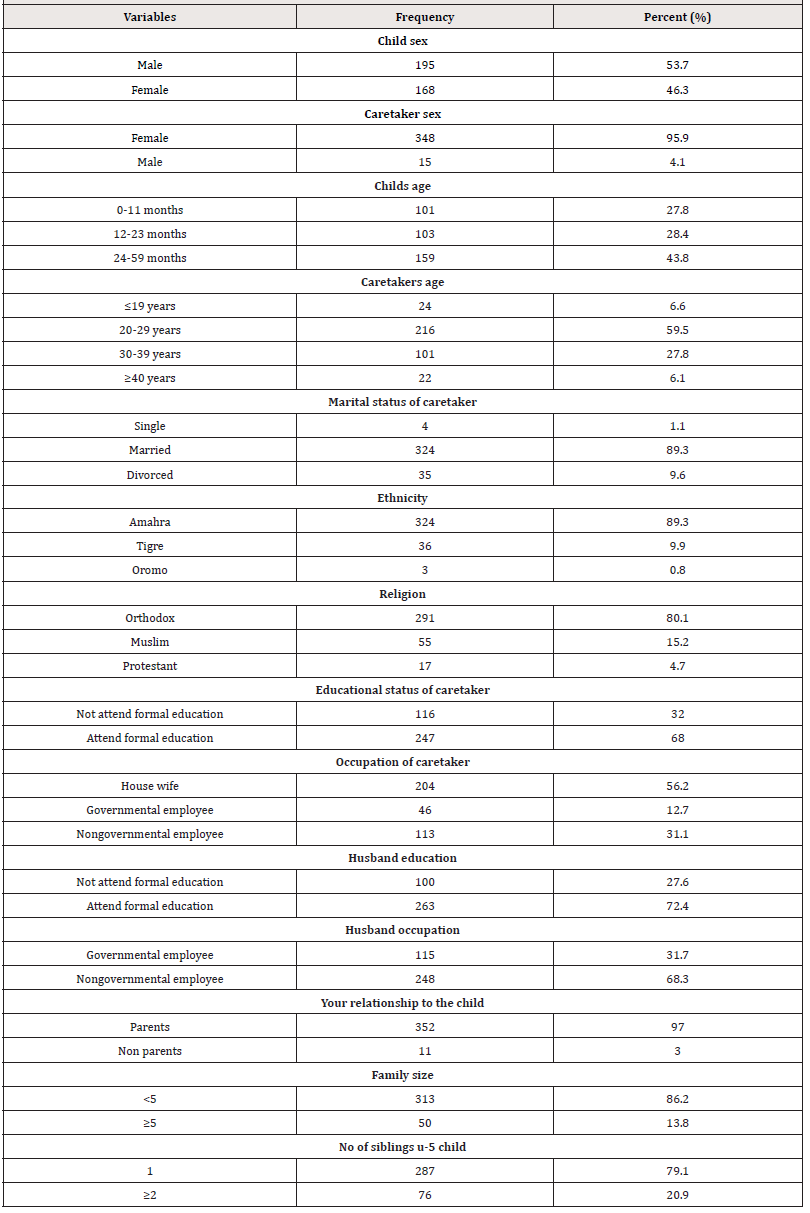
Table 1: Socio Demographic Characteristic of early health-seeking behaviors among caretakers of under-five children who have acute diarrhea illness at Gondar town, health centers Northwest Ethiopia, 2016 (N=363).
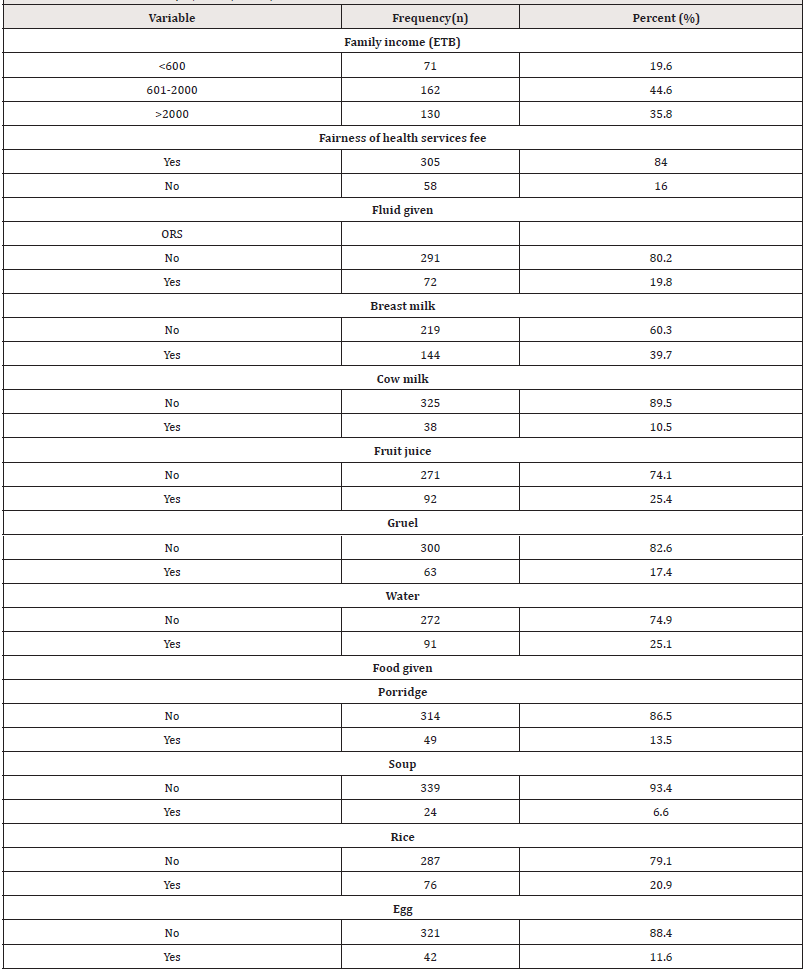
Table 2: Enabling factors to early health-seeking behaviors among caretakers of under-five children have acute diarrhea illness at Gondar town, health centers Northwest Ethiopia, 2016 (N=363).
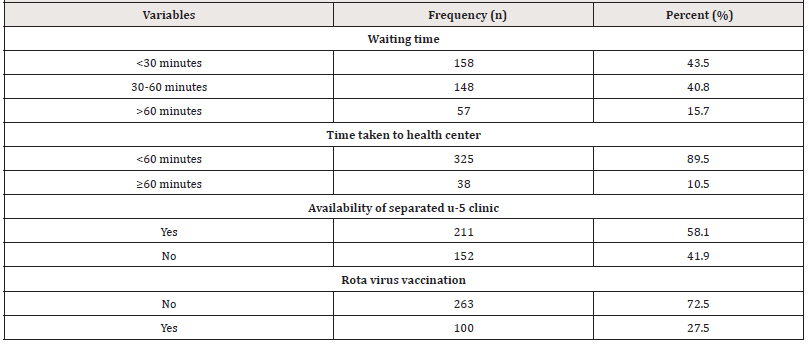
Table 3:Health system factors of early health-seeking behaviors among caretakers of under-five children have acute diarrhea illness at Gondar town; health centers Northwest Ethiopia, 2016 (N=363).
Perception of caretakers of child illness symptom and severity
Of the respondents, 163 (44.9%), 165(45.5%), and 35(9.6%) perceived child illnesses as severe, moderate, and mild, respectively; 244(67.2%), 237(65.3%), 171(47.1%), and 118 (32.5%) were aware of symptoms, such as dehydration, vomiting, fever, lethargy, and inability to drink or breastfeed, respectively (Table 4).
Prevalence of HSB
The magnitude of early health-seeking behaviors noted in this study was 22.6% (95% CI: 18.5-27.3) (Figure 1).
Associated factors of early health seeking behavior
Variables such as age, sex of the child, marital status, educational status, occupation, family size, income, availability of IMNCI clinic, waiting time, perceived health status, heard about danger sign of diarrhea, given breast milk/ORS, dry mouth, vomiting, lethargy, and bloody diarrhea were entered into the univariable analysis. The selected variables for multivariable logistic regression analysis were waiting time, perceived health status, and given breast milk/ORS. This study found that waiting time was statistically associated with EHSB among caretakers of under-5 children who have acute diarrhea. The probability of EHSB was 2.15 times to be higher among caretakers who had to wait time less than one hour (AOR=2.15; 95% CI: (1.13-4.10). The current study identified that mild health status was significantly associated with EHSB. The likelihood of having EHSB was 2.62 times to be higher among caretakers who have perceived mild condition (AOR=2.62; 95% CI: (1.02-6.70). This study found that fluid given breast milk/ORS was statistically associated with EHSB among caretakers of under-5 children who have acute diarrhea. The less likelihood having EHSB were (AOR=0.38; 95% CI: (0.19 - 0.78) (Table 5).

Figure 1: The prevalence of early health-seeking behavior of childhood acute diarrheal illness at Governmental health centers in Gondar town, northwest Ethiopia, 2016 (n=363).
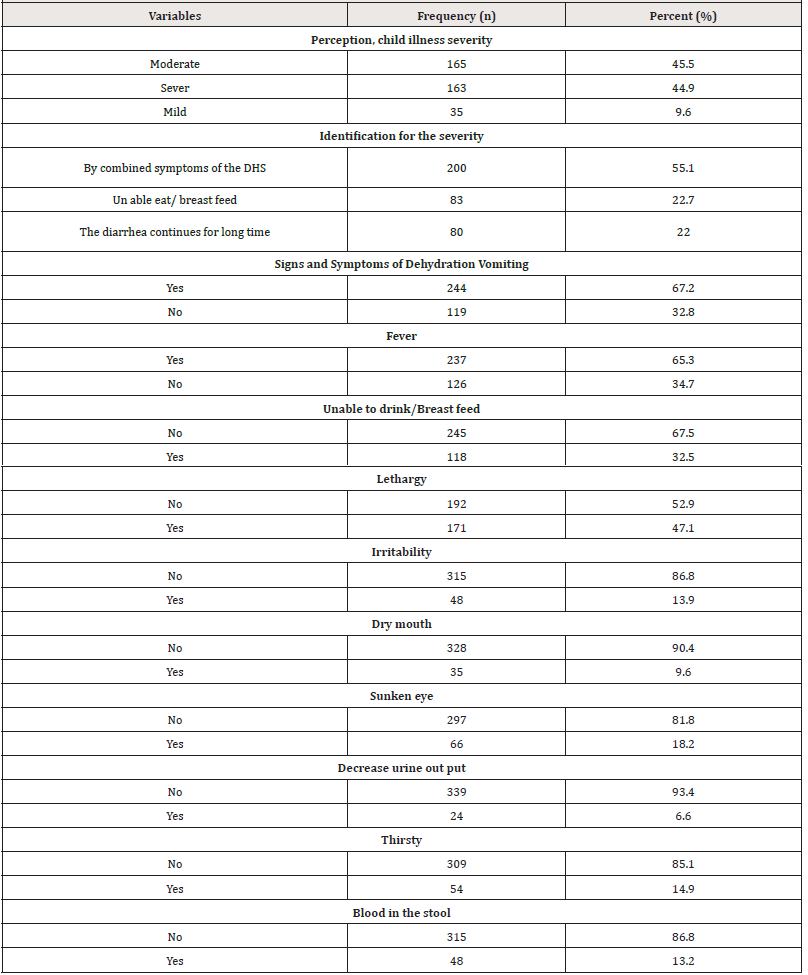
Table 4:The severity and symptom type perceived by caretakersofunder-5 children have acute diarrhea at governmental health centers in Gondar town, northwest Ethiopia, 2016 (n=363).
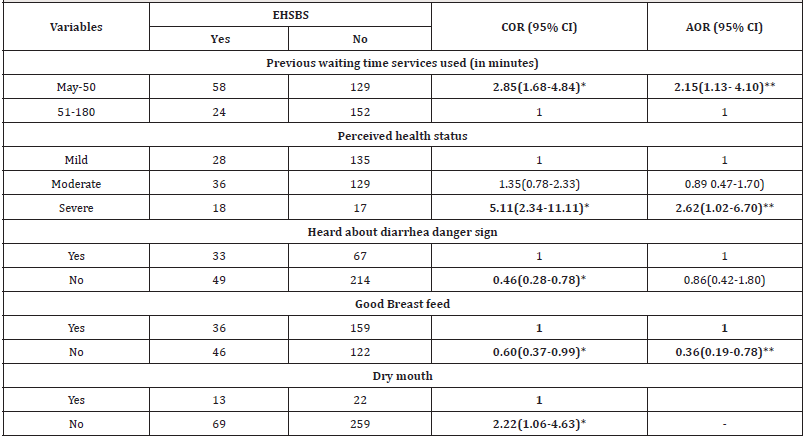
Table 5:Bi-variable & multivariable logistic analysis of factors associated early health-seeking behaviors among caretakers of under-five children have acute diarrhea illness at Gondar town, health centers Northwest Ethiopia, 2016 (n=363).
*Note: = statistically significant at P- values ≤0.05 at bi-variable analysis. The model adequately fits the data at p –value 0.625 (Hosmer&Lemeshow Test; for goodness of fit), 1=reference**= statistically significant at P-values ≤0.05 in multivariable analysis 5-50.
Discussion
In this study, the magnitude of early health-seeking behavior of caretakers to wards childhood acute diarrheal illnesses was 22.6% (95% CI: 18.5-27.3). This is in line with studies done in Ethiopia(22.6%)(23),Nigeria(21.33%)(1), and Bangladesh (22.1%) (24). The possible explanation might be that most caretakers in developing countries have not cultured health services early. This is due to low health awareness and they thought diarrhea is related to teeth eruption and culturally not harm.
This finding is comparatively high from previous studies done in Ethiopia(0.6%)(25), and Dhaka and Bangladesh(6%)(13). This might be because caretakers try different practices like that going to traditional healers and drug shops. If not resolved after such trials, they may come to the health center lately.
This finding is lower than those studies conducted in the urban slums of Kolkata, India (47.6%), Pakistan (29%)(18, 26), and Niger(70.4%)(27). This might be due to the variation in health infrastructure, socio-demographic dissimilarity, cultural differences, and the extent of access to health information of caretakers who seek early health care. Our finding is also lower than those of studies conducted in Ethiopia (32%), (32.7%), and (35%)(8, 23, 28). These national studies used pooled data, a large sample size, and included both urban and rural areas, while ours focused on urban settlements only. That is why the finding of the national study was higher than the current.
Increased the perceptions of caretakers about EHSB can decrease under-five children morbidities and mortalities which is an indicator of family health promotion and national growth(29). In this study, caretakers who waited time less than one hour in the previous services were 2.15 times earlier than those longer than one hour. This is supported by studies conducted in Nigeria(1), and South Africa(28). The reason is long waiting time affects the awareness of early health-seeking behavior of caretakers and leads to delays.
In this study, the occurrence of early health-seeking behaviors of caretakers was 2.62 times higher among caretakers who perceived their children as severe conditions than mild. This is supported by studies done in Kenya (30), Africa and Asia(31), and Dhaka, Bangladesh (13). This is due to caretakers perceiving a severe clinical condition of children on the first day were earlier health seekers than mild. Since severe cases hasten the parent to seek health early since when delayed they thought as fatal.
In this study caretakers who have well-breastfed children were 62% less likely to be early health seek than their counterparts. This is supported by studies done in Kenya(30) and Pakistan(26). The possible explanation is providing home antibiotics and children who have well breastfeeding has less likely too early health seeking outside the home. Because caretakers think that breastfed children are well and can recover by themselves at the home.
Limitation
This study was not triangulated, and the paucity of similar literature on early care-seeking behaviors of caretakers relating to childhood diarrheal illness has limited the discussion.
Conclusion
Overall, early health-seeking behaviors of caretakers of underfive children with acute diarrhea were low. Perceived severe illness status, waiting time and well-breastfeeding child were factors significantly associated with EHSB.
Recommendations
Encourage mothers/caretakers to come to health institutions on the first day of illness severe, facilitating the health care services to reduce clients’ waiting times, and encouraging the breastfeeding mother to come early before the child’s illness in severe conditions are some of the author’s recommendations.
Ethics Approval and Consent to Participate
Ethical clearance was obtained from the School of Nursing University of Gondar, College of Medicine and Health Sciences Ethical Review Committee in a letter Ref. No. N/D/533/02/2016. Cooperation letters were obtained from Gondar town health offices to ensure the permission and support of all health centers. The heads of all health centers permitted us to collect data. Verbal consent was taken from the respondents. During data collection at each selected health center, the aim of the study was clearly explained to respondents. Respondents were assured about the confidentiality of the information they provided and about their rights to refuse to participate.
Availability of Data and Materials
All necessary data generated or analyzed during this study are included in this manuscript.
Author’s Contributions
DGK wrote the proposal, supervised the data collection process, analyzed, presented the data and drafted the manuscript. MMK approved the proposal with revisions, participated in data analysis and manuscript preparation. DBA wrote the proposal and first draft of manuscript.
Acknowledgements
Our gratitude goes to the University of Gondar, College of Medicine and Health Science School of Nursing for the Approval of the Ethical Clearance. The authors would like to thank data collectors, field supervisors, study participants, Gondar Health Offices, health center leaders, and health professionals for their unreserved contributions to the success of this study.
Conflict of Interest
None.
References
- Olenja J (2003) Health seeking behaviour in context. East Afr Med J 80(2): 61-62.
- Chandwani H, Pandor J (2015) Healthcare-Seeking behaviors of mothers regarding their children in a tribal community of Gujarat, India. Electronic physician 7(1): 990-997.
- Aigbokhaode AQ, Isah EC, Isara AR (2015) Health seeking behaviour among caregivers of under-five children in Edo State, Nigeria. (SEEJPH).
- Gebrehiwot EM, Berheto TM, Worku A, Darebo TD, Sibamo EL (2015) Childhood diarrhea in Central Ethiopia: determining factors for mothers in seeking modern health treatments. Science Journal of Clinical Medicine 4(1): 4-9.
- Khajeh A, Vardanjani HM, Salehi A, Rahmani N, Delavari S (2019) Healthcare-seeking behavior and its relating factors in South of Iran. J Educ and Health Promot 8: 183.
- WHO (2017) Diarrhea disease in under five children. Geneva, Switzerland.
- CSA (2011) Central statistical agency Ethiopia and ICF international. Ethiopia demographic and health survey 2010. Maryland UAA, Ethiopia, and Calverton.
- Webair HH, Bin Gouth AS (2013) Factors affecting health seeking behavior for common childhood illnesses in Yemen. Patient Prefer Adherence 7: 1129-1138.
- Wambui WM, Kimani S, Odhiambo E (2018) Determinants of health seeking behavior among caregivers of infants admitted with acute childhood illnesses at Kenyatta National Hospital, Nairobi, Kenya. Int Journal Pediatr : 5190287.
- Assefa T, Belachew T, Tegegn A, Deribew A (2008) Mother’s health care seeking behavior for childhood illnesses in derra district, northshoa zone, oromia regional state, ethiopia. Ethiopian Journal of Health Development 18(3): 87-94.
- Manna B, Nasrin D, Kanungo S, Roy S, Ramamurthy T, et al. (2013) Determinants of health care seeking for diarrheal illness in young children in urban slums of Kolkata, India. Am J Trop Med Hyg 89(1_Suppl): 56-61.
- The World Health Organization (WHO) and the United Nations Childre's Fund (UNICEF) (2009) Clinical management of acute diarrhea. Geneva: World health Organization and UNCEF.
- Geldsetzer P, Williams TC, Kirolos A, Mitchell S, Ratcliffe LA, et al. (2014) The recognition of and care seeking behaviour for childhood illness in developing countries: a systematic review. PloS one. 9(4): e93427.
- Levine GA, Walson JL, Atlas HE, Lamberti LM, Pavlinac PB (2017) Defining pediatric diarrhea in low-resource settings. J Pediatric Infect Dis Soc 6(3): 289-293.
- Thapar N, Sanderson IR (2004) Diarrhoea in children: an interface between developing and developed countries. Lancet. 363(9409): 641-653.
- De Silva MA, Wijekoon A, Hornik R, Martines J (2001) Care seeking in Sri Lanka: one possible explanation for low childhood mortality. Soc Sci Med 53(10):1363-1372.
- Quadri F, Nasrin D, Khan A, Bokhari T, Tikmani SS, et al. (2013) Health care use patterns for diarrhea in children in low-income periurban communities of Karachi, Pakistan. Am J Trop Medicine Hyg 89(1_Suppl): 49-55.
- Page AL, Hustache S, Luquero FJ, Djibo A, Manzo ML, et al. (2011) Health care seeking behavior for diarrhea in children under 5 in rural Niger: results of a cross-sectional survey. BMC public health 11(1): 389.
- Daniels J, Zweigenthal V, Reagon G (2017) Assessing the impact of a waiting time survey on reducing waiting times in urban primary care clinics in Cape Town, South Africa. J Public Health Afr 8(1): 639.
- Fissehaye T, Damte A, Fantahun A, Gebrekirstos K (2018) Health care seeking behaviour of mothers towards diarrheal disease of children less than 5 years in Mekelle city, North Ethiopia. BMC Res Notes 11(1): 749.
- Simieneh MM, Mengistu MY, Gelagay AA, Gebeyehu MT (2019) Mothers’ health care seeking behavior and associated factors for common childhood illnesses, Northwest Ethiopia: community based cross-sectional study. BMC Health Services Res 19(1): 59.
- Kaur A, Chowdhury S, Kumar R (1994) Mothers' beliefs and practices regarding prevention and management of diarrheal diseases. Indian Pediatr 31(1): 55-57.
- Peltzer K, Promtussananon S (2003) Health care-seeking behaviour for child illnesses among rural mothers in South Africa: a pilot study. Health SA Gesondheid 8(2): 3-13.



 We use cookies to ensure you get the best experience on our website.
We use cookies to ensure you get the best experience on our website.